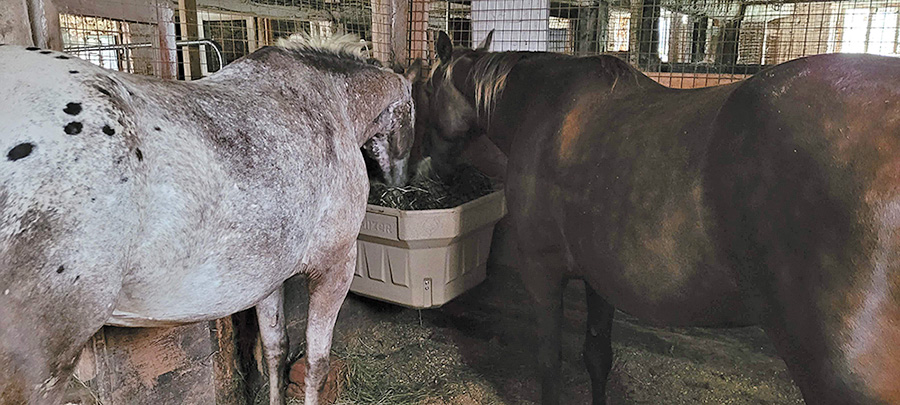
"The analysis showed significant differences between our hay."
By Sue Wilson
An old dairy farmer told me that 2023 was his worst year for harvesting hay since 1992. I believe it. With a dry May, followed by record amounts of rain in June and July 2023, the harvesting of high quality, first cut hay was seriously challenged. We simply could not ”make hay while the sun shines” because we did not have the consecutive days of sunshine required to cut, dry and bale hay this summer.
As a result, we have ended up with a mixed bag of hay for the winter: two different sources harvested over 3 different months. Working with Madeline Boast, our equine nutritionist, all 3 major versions have been tested so that we can buffet the hay to meet the changing needs of our horses over the winter.
Our herd currently consists of 6 horses. They too, are a mixed bag. There are 3 easy keepers (gypsy vanner, rocky mountain horse, appaloosa) and 3 harder keepers (senior horses, all over 20). Coming into the winter, they all have adequate body condition scores, except the gypsy vanner who is somewhat obese at 7.5, despite muzzling all summer long. The other 2 easy keepers have histories of equine metabolic syndrome and laminitis. We need to carefully consider Non Structural Carbohydrates (NSC) levels for these 2 horses to keep them healthy.

Chewie and Jasper sharing high NSC hay that was pre-soaked in their OptiMizer InStall. To soak hay, plug the drainage hole, add hay and boiling water. When the water cools, pull the plug and drain the water into a bucket under the feeder.
Our horses live outside all the time on a track system with free access to shelter in a large, cozy bank barn. In winter, they tend to be outside most of the time day and night, and most are never blanketed. They are on a forage-first diet and always have access to hay in their OptiMizer slow feeders. They consume what they need, which changes with the weather. For example in bitter cold winter weather, they may consume double the amount of hay, in order to generate the body heat needed to keep themselves warm.
The analysis showed significant differences between our hay (Table 1). The May hay has high calories, protein and sugar. The June hay has lower calories and protein, but very high sugar. The July hay was very mature when it was harvested and is the lowest nutritionally, but also thankfully low in sugar. The July hay had the highest moisture count level and is most at risk for mold. It is also the least palatable hay for the horses based on how picky they are when they are eating it.

One of the most striking things about our hay analysis was the wide range in calories between samples. If we were dispensing the hay at a Tim Hortons drive-thru, the May hay is like a Boston Cream Donut (310 cals) while the July hay is like an Egg White Breakfast Sandwich (240 cals). And the May hay seems the most palatable, based on how the horses gobble it … just like I would eat a Boston Cream Donut.
Here is the buffet we are planning for our horses this winter:
● For October - November, we will feed the July hay. The horses still have some pasture, the weather is not too cold and we want to use it up in case of mold. We load the OptiMizers with bales of July hay, quickly look through the flakes and pull out/discard any flakes that show signs of mold or dust. We’ve discarded about 2% of the hay so far.
● As the weather gets cold, we will start mixing in a few flakes of May hay, to a maximum of 25% of the mix per OptiMizer. When the July hay is used up, we will switch the remaining 75% to the June hay to balance calories and protein. We will consider putting small (1.25”) nets on the OptiMizers to reduce the feed rate of this yummy hay.
● We may soak some of the June hay in our OptiMizer InStalls to lower the NSC for the 2 metabolic horses.
2023 was a challenging year for hay. Good horse hay is in short supply and expensive. More than ever, it is important to get hay analyzed so that you can make informed choices on how to fully optimize what you have and how you feed it.
For more information visit https://hayoptimizer.net/


